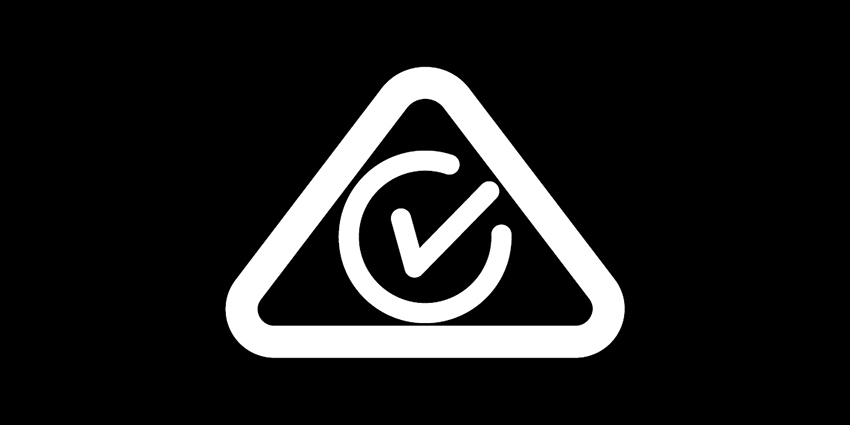Damaged electrical cords and appliances
Damaged electrical cords and appliances are dangerous and should never be used.
There is a danger of electric shock, burns and other injuries if someone comes in contact with a damaged appliance. This risk is greatest around cords and plugs, where the appliance connects to the electrical supply
To stay safe:
- Check electrical appliances and cords for damage, such as exposed wires or frayed cords.
- Stop using a damaged appliance immediately.
- Turn off the power and then unplug the appliance.
- Never attempt DIY repairs and engage a licensed electrician.
Buying electrical goods online
- Keep appliances away from known hazards, such as keeping electricity away from water.
Using electricity safely near water fact sheet, - When shopping online look for the RCM (below) to ensure it’s safe to use in Australia.
- Appliance manufacturers are required to provide 'how-to-use' instructions with their products. Always check that the instructions are provided and always read and follow the instructions before using the appliance.
- If you don’t know the origin of an electrical appliance or equipment (for example, it’s been purchased second hand), then it should be inspected by a qualified professional and tested to ensure it is safe to use.
- Examine electrical appliances that have been in storage, such as electric blankets which come out in wintertime, should be checked for wear and tear before use.
- Appliances using damaged and wrongly connected cords and plugs are dangerous. Although it is legal to connect your own plugs to flexible cords, a faulty connection can kill. Ready-made extension cords will be safer and may even be cheaper. For appliance cords, see your local service agent.
- For the protection of both the customer and the people selling used electrical appliances or equipment, the law requires that they are sold are in a safe condition.
- If your electric heater has a dust filter, clean it frequently as it reduces the risk of clogging, overheating and electrical fires.
Appliance approval marks
Exposure to the risks of electricity is greatest at the point where it does its job - at electrical appliances and the cords which connect electrical appliances to the power supply.
For this reason, the Electricity Act 1945 prohibits the sale of household electrical appliances unless 'approved' by an Australian regulatory authority.
Check for an approval number or a regulatory compliance mark (below) on all household appliances and their plugs. Certification can also be confirmed by searching for the model number by clicking on the button below.
Electrical Equipment Safety System website
Regulatory Compliance Mark (RCM):
Other markings:
| Q<number | S<number> | ASA<number>EA | SAI SMK EA<number> |
| ESO<number> | C/A<number> | GMA<number>EA | SGS EA<number> |
| NSW<number> *after 24 Feb 2005 | V<number> | CBA<number>EA | TUV<number>EA |
| N<number> *before 24 Feb 2005 | ESV<number> | SAA<number>EA | A<number>EA |
| T<number> | AGA<number>EA | SAI TE EA<number> | U<number>EA |
Visit the link below to view unsafe and dangerous electrical appliances.
Prohibited electrical appliances
Safe use of portable generators
If your electricity has been interrupted, a portable generator can be a convenient way to maintain power to some appliances. However, it can pose serious health and safety risks if not installed or used correctly.
To safely use a generator to power your house or office electrical installation you must have a changeover switch installed by a licensed electrical contractor. The changeover switch safely supplies power from a generator to the wiring installed in the premises and prevents power being fed back into the electricity grid.
More relevant information can be found here:
- Importing, selling or hiring electrical appliances and equipment
- Pins on plug tops - insulation requirements
Follow these simple steps to safely use your portable generator:
Don’t:
- Do not DIY electrical work. A licensed electrical contractor must be engaged to safely install a changeover switch to connect a generator to your home or office wiring.
- Do not modify and plug generators directly into power points or into the home or office wiring. Plugging a generator into a power point in your home or office will send electricity through the switchboard into the electricity network causing a safety hazard to you, your family, neighbour or tradespeople working on the electricity network.
- Do not use modified leads to connect a generator to the wiring of your house. These are a serious safety hazard and can cause an electric shock.
- Do not plug a generator into any part of the electricity network. This will feed electricity back into the network causing a safety hazard.
- Do not overload your generator. Refer to the rated wattage of your generator to determine the number of appliances it can safely power.
- Do not overload power boards by ‘piggy backing’ plugs into one socket or using double adaptors.
- Do not operate or connect to a generator that is sitting in water or while you are standing in water.
Do:
- Appliances can be plugged directly into the generator. However, always read the manufacturer’s instructions carefully.
- Use a heavy duty extension cord rated for outdoor use.
- Always follow the manufacturer’s instructions for earthing the generator.
- Ensure appliances are turned off before connecting them to your generator. Once connected, turn them on one at a time to avoid overloading the generator.
- Only use a generator that complies with AS 3010 and has the Australian Standard mark on the generator.
- Ensure all power leads and boards are in good working order and are not damaged.
- Ensure power boards and leads are placed in areas that are dry and where they will not be damaged.
- Carbon monoxide hazards
Petrol or diesel powered generators produce toxic carbon monoxide fumes that can cause serious health issues or can be fatal. Always run your portable generator outdoors in a well-ventilated area and keep it well away from open windows.



